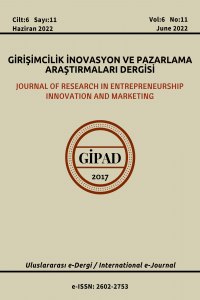Rutin Ofis Hizmetlerinde İnovasyon Tasarımı
İnovasyon bir disiplin konusu haline gelmektedir. Bu çalışmanın amacı, çalışanları ezberden ve bilgi yükünden kurtarmak ve tasarım düşüncesi yoluyla adım adım inovasyonda güven kazanmalarına yardımcı olmaktır. Çoğu çalışan, özellikle rutin ofis hizmetlerinde olanlar, kendilerini yenilikçiliğin bir parçası olarak görmemektedirler. Bu makale, çalışanların inovasyon sürecine aktif katılımını güçlendirme yöntemini göstermeyi amaçlamaktadır. İnovasyona uzak gibi görünen, statik, monoton bir arka plan ofis hizmeti sunan birimler dahi inovasyonun kaynağı olmaktalar. Bu makalede bir tekstil firmasında böyle bir ofis hizmeti sunan ithalat satın alma (buy-in) biriminde gerçekleştirilen inovasyon çalışması örnek olarak gösterilmektedir. Tasarım düşüncesinde aşamalar; paydaşları dinleme, çıkarımları gruplama, fikirleri üretme, prototipler kurgulama ve yine paydaşlardan geri dönüşüm alma olarak ilerlemektedir. Yaratıcı güven, tasarım düşüncesi inovasyon metodolojilerini yavaş ve kararlı eylemlerle uygulayarak elde edilmektedir.
Anahtar Kelimeler:
Aktif katılım, inovasyon, tasarım düşüncesi, rutin işler
Designing Innovation at Routine Office Services
Innovation is becoming a discipline. The aim of this study is to release employees from memorization and information burden and to help them gain creative confidence step by step through design thinking. This article aims to strengthen the active participation of employees in the innovation process. Most employees, especially those are in routine office services, do not see themselves as a part of innovation. However, even units that offer a static, monotonous background office service that seem distant to innovation can be the source of innovation. This article demonstrates the innovation work in a buy-in unit that provides such an office service in a large textile company. The stages of design thinking are progressing as listening to stakeholders, grouping insights, generating ideas, editing prototypes and getting feedback from stakeholders. Creative trust is achieved by applying design thinking innovation methodologies with step by step with determined actions.
Keywords:
Active participation, innovation, design thinking, routine jobs,
___
- Akın, M.Ş. (2019). Farklı Bakış Açısı Kazanmak İçin Beyin Fırtınası Modelleri, Süleyman Demirel Üniversitesi Vizyoner Dergisi, 10, 23: 15-24.
- Brown, T. & Martin, R. (2015). “Design for Action”, Harvard Business Review, 55-64
- Brown, T. & Wyatt, J. (2010). “Design Thinking for Social Innovation”, Stanford Social Innovation Review.
- Brown, T. (2008). “Design Thinking”, Harvard Business Review, 25 (6):123-132.
- Brown, T. (2009). Change by Design: How Design Thinking Transforms Organizations and Inspires Innovation, Harper Business, New York.
- Dorst, K. (2011). “The Core Of ‘Design Thinking’ And Its Application”, Design Studies, 32, 6: 521-532.
- Emek, F. (2023). Gümrük Tarife İstatistik Pozisyonu (GTİP) Nedir? https://www.eritela.com/ gumruk-tarife-istatistik-pozisyonu-gtip-nedir/
- Gümrük Vergisi Kanunu (2019). Yanlış İthalat Beyanından Alınan Ceza. https://www.mazars.com.tr/Anasayfa/Blog/Makaleler/Ithalatta-Alinan-KDV-de-Ceza-Uygulamasi
- http://www.youtube.com/watch?v=-FzFk3E5nxM
- Kelley, T & Littman, J. (2001). The Art of Innovation: Lessons in Creativity from IDEO, America's Leading Design Firm Crown Business, Crown Business, New York.
- Kelley, T. & Kelly, D. (2014). Yaratıcı Özgüven, Optimist Yayınları, İstanbul.
- Kelley, T. (2005). The Ten Faces of Innovation, Doubleday, New York.
- Kelley, T., & Littman, J. (2001), The Art of Innovation: Lessons in Creativity from IDEO, America's Leading Design Firm Crown Business. Crown Business, New York.
- Kim, C. W. & Mauborgne, R. (2004). Blue Ocean Strategy. Harvard Business School Press.
- Kumar, V. (2012). 101 Design Methods: A Structured Approach for Driving Innovation in Your Organization, Wiley, Chicago:
- Liedtka J & Ogilvie, T. (2011). Designing for Growth, Columbia Business School, New York.
- Liedtka, J. (2018). Why Design Thinking Works. Harvard Business Review, September
- Liedtka, J., King, A. & Bennett,K. (2014). Solving Problems with Design Thinking, Columbia Business School, New York.
- Luma Institute. (2012). Innovating for People Handbook of Human-Centered Design Methods, LUMA Institute, Chicago.
- Luma Institute. (2014). “Innovation Taxonomy”, Harvard Business Review, 37 (1): 111-112 October.
- Pine, J. & Gilmore, J. (2011), The Experience Economy, Cambridge: Harvard Business Review Press.
- Pink, D. (2006). A Whole New Mind, Riverhead Trade, New York.
- Sara L. Beckman, C. & Barry, M. (2007), Innovation as a Learning Process: Embedding Design Thinking. California Management Review, 50 (1), 25-49.
- Standford Design School (2009). d.school bootcamp bootleg.
- Stanford Design School (2014). Design Thinking Virtual Crash Course
- Steinbeck, R. (2011). “Building Creative Competence in Globally Distributed Courses Through Design Thinking”, Comunicar, 37 (19): 27-35.
- Tschimmel, K (2017). Evolution 62 Innovation and Design Thinking Model. Mindshake, Porto.
- Tschimmel, K. (2012). Design Thinking as an Effective Toolkit for Innovation. In: Proceedings of the XXIII ISPIM Conference: Action for Innovation: Innovating from Experience. Barcelona.
- Yayın Aralığı: Yılda 2 Sayı
- Başlangıç: 2017
- Yayıncı: Mehmet MARANGOZ
Sayıdaki Diğer Makaleler
Gazetecilikte Artırılmış Gerçeklik Kullanımının Haber Kavramı Üzerinden Değerlendirilmesi
Birol AKGÜL, Ebrar Feyza KILIÇ, Zeynep AYER
Rutin Ofis Hizmetlerinde İnovasyon Tasarımı
Sahiplenmeden Tüketemez miyiz? Dijital Paylaşım Ekonomisinde Kiralama Üzerine Kavramsal Bir İnceleme
Kripto Para Piyasalarında Etkinlik; Haftanın Günü Etkisi: Bitcoin ve Litecoin Örneği
Kadın Girişimci Profilinin Belirlenmesine Yönelik TR72 Bölgesinde Bir Araştırma
Kâr Amaçsız Örgütlerin Web Sayfalarının Müşteri Odaklılık Bağlamında Değerlendirilmesi
Mustafa ECE, Muhammet Ali TİLTAY
Kurumsal Girişimcilik ve Yeniliğin İşletme Performansına Etkisi
